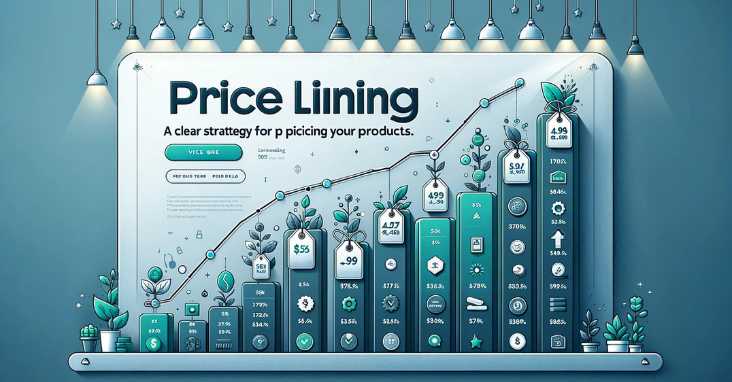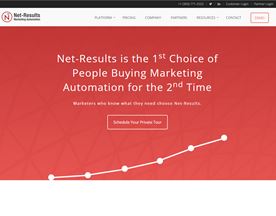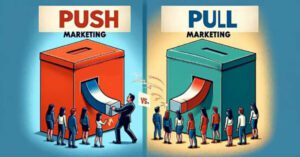What is price lining? Price lining is a strategy that sets various price points for a product range to target different customer segments, enhancing sales.
Price-lining is a pricing strategy that involves setting different prices for products within the same product line. This strategy is commonly used by retailers and businesses to appeal to different customer segments and maximize profits. Price lining is based on the idea that customers have different perceptions of value and are willing to pay different prices for similar products based on factors such as quality, features, and brand reputation.

Understanding Price Lining
Price lining involves grouping products into different price categories based on their perceived value and setting a fixed price for each category. For example, a clothing retailer might have a basic line of t-shirts priced at $10, a premium line of t-shirts with better quality materials and features priced at $20, and a luxury line of t-shirts with high-end materials and exclusive designs priced at $50. This allows the retailer to cater to different customer segments and capture a larger share of the market.
Price Lining Strategy
Price lining is a strategic pricing approach that can be used to increase profitability and market share. By offering different price points for similar products, businesses can appeal to a wider range of customers and increase sales volume. However, price lining can also have some drawbacks, such as potentially confusing customers and reducing brand equity. It is important for businesses to carefully consider their pricing strategy and monitor its performance to ensure that it is effective and sustainable.
Key Takeaways
- Price lining is a pricing strategy that involves setting different prices for products within the same product line.
- Price lining can be used to appeal to different customer segments and increase profits, but can also have drawbacks such as confusing customers and reducing brand equity.
- Businesses should carefully consider their pricing strategy and monitor its performance to ensure that it is effective and sustainable.
Understanding Price Lining
Definition and Concept
Price lining is a pricing strategy that involves offering different products or services at different price points. This strategy is based on the principle that consumers have different preferences and willingness to pay for products or services of varying quality. By offering products or services at different price points, businesses can cater to the needs of different consumer segments and maximize their profits.
Price lining involves grouping products or services into different categories based on their quality, features, or other attributes. Each category is then assigned a specific price point, which is typically a round number that is easy for consumers to remember. For example, a business may offer a basic, mid-range, and premium version of a product, each priced at $10, $20, and $30, respectively.
Historical Evolution
The concept of price lining has been around for centuries, but it was not until the 20th century that it became a popular pricing strategy among businesses. In the early days of price lining, businesses would offer products at different price points based on their cost of production. However, as competition increased and consumers became more discerning, businesses began to adopt more sophisticated pricing strategies.
Today, price lining is widely used by businesses in various industries, including retail, hospitality, and healthcare. It is particularly popular among businesses that offer a range of products or services with varying levels of quality or features.
According to a study by Harvard Business Review, price lining can be an effective strategy for businesses looking to maximize their profits. However, it is important to ensure that the price points are set appropriately based on consumer demand and the cost of production. Businesses that offer products or services at price points that are too high or too low may struggle to attract customers or achieve their desired profit margins.
For more information on price lining and other pricing strategies, check out this resource from Investopedia.
Price Lining Strategy
Price lining is a pricing strategy that involves setting different prices for products or services based on their quality, features, or benefits. This strategy is commonly used by businesses to appeal to different customer segments and maximize profits. In this section, we will discuss how to implement price lining and the role of market trends in this strategy.
Implementing Price Lining
To implement price lining, businesses need to categorize their products or services into different tiers based on their quality, features, or benefits. Each tier should have a distinct price point that reflects its value proposition. For example, a clothing store might have a basic line of t-shirts priced at $10, a mid-tier line of polo shirts priced at $25, and a premium line of dress shirts priced at $50.
Proper implementation of price lining requires a deep understanding of the target market and their willingness to pay for different product tiers. Businesses need to conduct market research and analyze customer data to determine the optimal price points for each tier. It is also important to consider the competitive landscape and ensure that the prices are competitive and attractive to customers.
The Role of Market Trends
Market trends play a crucial role in price lining strategy. Businesses need to stay up-to-date with the latest trends and adjust their pricing strategy accordingly. For example, if there is a growing demand for eco-friendly products, businesses might introduce a new tier of environmentally friendly products at a premium price point.
Marketing strategy is also important in price lining. Businesses need to effectively communicate the value proposition of each tier to customers and create a sense of exclusivity and prestige around premium products. This can be achieved through targeted advertising, product packaging, and in-store displays.
Overall, price lining is a powerful pricing strategy that can help businesses increase profits and appeal to different customer segments. By properly implementing price lining and staying up-to-date with market trends, businesses can create a pricing strategy that is both effective and profitable.
Here is a resource with more information on price lining strategy.
Product Line Pricing
Product line pricing refers to the strategy of pricing different products within the same product line at different prices. This pricing strategy is commonly used by businesses to target different segments of customers and to maximize profits.
Differentiating Products
One of the main benefits of product line pricing is the ability to differentiate products based on their features and benefits. By offering a range of products at different price points, businesses can appeal to customers with different needs and budgets. For example, a technology company may offer a basic laptop model for budget-conscious customers, a mid-range model for average users, and a high-end model for power users who require advanced features.
Setting Price Points
Setting the right price points for each product in the line is crucial to the success of product line pricing. Businesses must take into account factors such as production costs, competition, and customer demand when setting prices. One common approach to setting price points is to use a price ladder, where products are priced in increments based on their features and benefits.
To implement product line pricing effectively, businesses must carefully analyze their target market and understand their needs and preferences. They must also be able to communicate the value of each product in the line to customers.
For more information on product line pricing and how it can benefit your business, check out this resource from Investopedia.
Advantages of Price Lining

Price lining is a pricing strategy that involves setting different prices for products based on their quality, features, and other attributes. This strategy has several advantages that businesses can benefit from.
Marketing and Sales Benefits
One of the main advantages of price lining is that it can help businesses attract different types of customers. By offering products at different price points, businesses can appeal to customers with different budgets and preferences. This can increase sales and revenue, as customers are more likely to find a product that suits their needs and budget.
Price lining can also help businesses differentiate their products from competitors. By offering a range of prices, businesses can create a perception of value and quality. This can help them stand out in a crowded market and attract new customers.
Inventory and Production Advantages
Price lining can also have inventory and production advantages. By offering a range of prices, businesses can better manage their inventory and production processes. They can focus on producing and stocking the products that are most in demand, while reducing inventory for products that are less popular. This can help businesses reduce costs and improve efficiency.
Another advantage of price lining is that it can help businesses manage their product life cycles. By offering products at different price points, businesses can extend the life of their products and generate more revenue over time. They can also introduce new products at different price points, which can help them capture new markets and increase sales.
Overall, price lining is a pricing strategy that can offer several benefits for businesses. By carefully selecting prices for products, businesses can attract different types of customers, differentiate themselves from competitors, and improve their inventory and production processes.
To learn more about price lining and its advantages, check out this resource from Investopedia.
Disadvantages of Price Lining

Price lining is a pricing strategy that involves setting different prices for different products within the same category. While it has its advantages, such as simplifying the buying process for consumers and increasing the perceived value of higher-priced items, it also has its disadvantages.
Potential Risks
One potential risk of price lining is that it can lead to lost sales. If a customer is looking for a product within a certain price range and all of the options are priced above or below that range, they may choose to go to a competitor instead. Additionally, if a customer perceives that a higher-priced item is not significantly better than a lower-priced item, they may choose the lower-priced option, resulting in lost revenue for the company.
Another potential risk is that price lining can lead to inventory management issues. If a company has too many products priced in the middle range, they may not sell as quickly as the higher-priced or lower-priced products, resulting in excess inventory and potential losses.
Consumer Perception Issues
Price lining can also have negative impacts on consumer perception. If a customer sees that a company has a wide range of prices for similar products, they may perceive the company as being greedy or dishonest. Additionally, if a customer perceives that a company is using price lining to take advantage of them, they may be less likely to do business with that company in the future.
Overall, while price lining can be an effective pricing strategy in certain situations, it is important for companies to be aware of the potential disadvantages and take steps to mitigate them.
Here is a resource with more information on price lining and its potential disadvantages.
Price Lining in Different Industries

Price lining is a pricing strategy used in various industries to help businesses set prices for their products or services. This strategy involves categorizing products or services into different price ranges, each with its own set price. This section will explore how price lining is used in different industries.
Retail and Hospitality
Price lining is commonly used in the retail and hospitality industries. Retailers use this strategy to offer a range of products at different price points, making it easier for customers to find products that fit their budget. For example, a clothing store may have different lines of clothing, each with its own price range, such as a basic line, a mid-range line, and a high-end line.
Similarly, hotels and restaurants use price lining to offer different levels of service at different price points. For instance, a hotel may offer standard rooms, deluxe rooms, and suites, each with its own set price. Restaurants may offer different menus or meal plans at different price points, such as a prix fixe menu or a la carte options.
Automobile and Technology
Price lining is also commonly used in the automobile and technology industries. Automobile manufacturers offer different models of cars at different price points, each with its own set of features and amenities. For example, a car manufacturer may offer a basic model, a mid-range model, and a luxury model.
Similarly, technology companies use price lining to offer different levels of technology at different price points. For instance, a smartphone manufacturer may offer different models of phones at different price points, each with its own set of features and capabilities.
Overall, price lining is a useful strategy for businesses in various industries to offer products or services at different price points. By categorizing products or services into different price ranges, businesses can appeal to a wider range of customers and increase their sales.
Here is a link to a resource with more information on price lining.
Consumer Response to Price Lining

Price lining is a pricing strategy that involves offering products at different price points. This strategy is often used by retailers to appeal to a wider range of customers. However, the success of this strategy depends on how well customers respond to it. In this section, we will examine the consumer response to price lining and its impact on purchase decisions and how customers adapt to economic conditions.
Impact on Purchase Decisions
Customers respond to price lining in different ways. For some customers, the availability of different price points can be a deciding factor in their purchase decision. For example, a customer may choose a lower-priced product if they perceive that the quality is not significantly different from the higher-priced product. On the other hand, some customers may view the higher-priced product as a status symbol or a sign of quality.
Price lining can also influence customer loyalty. Customers who are able to find products that meet their needs at a lower price point may be more likely to return to the retailer in the future. However, if a customer perceives that the retailer is offering lower-quality products at lower price points, this may have a negative impact on their loyalty.
Adapting to Economic Conditions
Price lining can also help customers adapt to economic conditions. During times of economic uncertainty, customers may be more price-sensitive and may look for lower-priced products. By offering products at different price points, retailers can appeal to customers who are looking for a bargain.
However, during times of economic prosperity, customers may be more willing to spend money on higher-priced products. In this case, price lining may not be as effective, as customers may be more interested in the quality and features of the product rather than the price.
Overall, the success of price lining depends on how well it is implemented and how customers respond to it. Retailers must carefully consider their customer base and economic conditions when implementing this pricing strategy.
Here is a resource with more information on pricing strategies.
Effective Marketing with Price Lining

Price lining is a pricing strategy that involves grouping products and services into categories based on their prices. This strategy is commonly used by businesses to simplify their pricing structure and make it easier for customers to understand the value of their products and services. Effective marketing with price lining involves utilizing advertising and promotion, as well as presentation and display techniques to attract and retain customers.
Advertising and Promotion
Advertising and promotion are essential components of effective marketing with price lining. By promoting the benefits of their products and services, businesses can attract new customers and retain existing ones. One effective way to promote products and services is by offering discounts or special offers to customers who purchase items from higher-priced categories. This can help to incentivize customers to try new products and services while also increasing their perceived value.
Another effective advertising and promotion technique is to use social media and other digital marketing channels to reach a wider audience. By creating engaging content that highlights the benefits of their products and services, businesses can attract new customers and retain existing ones. Additionally, businesses can use email marketing campaigns to target specific customer segments and promote products and services that are relevant to their needs.
Presentation and Display
Presentation and display are also important components of effective marketing with price lining. By presenting their products and services in an appealing and organized manner, businesses can increase their perceived value and attract new customers. One effective way to do this is by using color-coded pricing tags or labels to clearly indicate the prices of products and services within each category. This can help customers to quickly and easily identify the products and services that are within their budget.
Another effective presentation and display technique is to create visually appealing displays that showcase products and services within each category. By using eye-catching displays and signage, businesses can attract the attention of customers and encourage them to explore different products and services. Additionally, businesses can use product bundling techniques to encourage customers to purchase multiple items within each category, which can increase their perceived value and encourage repeat purchases.
In conclusion, effective marketing with price lining involves utilizing advertising and promotion, as well as presentation and display techniques to attract and retain customers. By using these techniques, businesses can simplify their pricing structure, increase their perceived value, and attract new customers. To learn more about price lining and other pricing strategies, check out this article from Forbes.
Analyzing Price Lining Performance

Price lining is a popular pricing strategy that involves setting prices for different products within a product line at different levels. This strategy is used by many businesses to target different customer segments and maximize profits. However, analyzing the performance of price lining requires a careful consideration of various factors.
Revenue and Profit Margins
One of the primary goals of price lining is to increase revenue and profit margins. By offering products at different price points, businesses can attract customers with different budgets and preferences. This can lead to increased sales and higher profits. However, it is essential to ensure that the pricing strategy is aligned with the cost structure of the business. Setting prices too low or too high can negatively impact profit margins.
To analyze the revenue and profit margins of price lining, businesses can use various financial metrics such as gross profit margin, net profit margin, and return on investment (ROI). These metrics can provide insights into the effectiveness of the pricing strategy and help businesses make informed decisions.
Market Changes and Adaptation
The market is constantly evolving, and businesses must adapt to stay competitive. Price lining is no exception, and businesses must monitor market changes and adjust their pricing strategy accordingly. For example, if a competitor introduces a new product at a lower price point, businesses may need to lower their prices to remain competitive.
To analyze market changes and adaptation, businesses can use various market research techniques such as customer surveys, focus groups, and competitor analysis. These techniques can provide valuable insights into customer preferences and market trends, allowing businesses to adjust their pricing strategy accordingly.
In conclusion, analyzing the performance of price lining requires a careful consideration of various factors such as revenue, profit margins, market changes, and adaptation. By using financial metrics and market research techniques, businesses can make informed decisions and optimize their pricing strategy for maximum profitability. For more information on price lining, check out this resource from Investopedia.
Frequently Asked Questions

How do businesses implement a price lining strategy in their product offerings?
Businesses can implement a price lining strategy by offering a range of products or services at different price points. These price points are often set based on the perceived value or quality of the product. For example, a clothing store may offer t-shirts at $10, $20, and $30 depending on the fabric, design, and brand. By doing so, businesses can cater to different segments of the market and increase their revenue.
What are the advantages of using price lining for a company?
Price lining can help companies increase their revenue by offering products at different price points. It can also help them cater to different segments of the market and increase their market share. Additionally, price lining can simplify the pricing process for businesses by reducing the number of price points and making it easier for customers to make purchasing decisions.
Can you provide examples of companies that successfully use price lining?
Apple is a well-known example of a company that successfully uses price lining in their product offerings. They offer different models of iPhones at different price points, ranging from the budget-friendly iPhone SE to the premium iPhone Pro Max. Another example is Starbucks, which offers coffee at different price points based on the size and complexity of the drink.
What impact does price lining have on consumer purchasing behavior?
Price lining can influence consumer purchasing behavior by making it easier for them to make purchasing decisions. By offering products at different price points, businesses can cater to different segments of the market and appeal to customers with different budgets. Additionally, price lining can create a perception of value and quality, which can influence consumers to purchase a higher-priced product.
How does price lining differ from other pricing strategies like bundle or captive pricing?
Price lining differs from other pricing strategies like bundle or captive pricing in that it offers products at different price points, rather than bundling products together or offering a low-priced product to capture a larger market share. Price lining can also be more flexible than other pricing strategies, as businesses can adjust their price points based on market conditions and consumer demand.
What are the potential drawbacks or challenges of adopting a price lining strategy?
One potential drawback of adopting a price lining strategy is that it can create confusion or frustration among customers who feel that they are being charged more for a similar product. Additionally, businesses may need to invest in market research and analysis to determine the optimal price points for their products. Finally, businesses may need to be flexible and adjust their price points based on market conditions and consumer demand to remain competitive.
For more information on price lining, check out this article from Investopedia.















